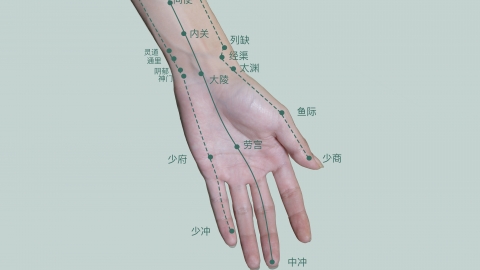What is the precise location and course of the Lung Meridian?
Under normal circumstances, the Lung Meridian refers to the Hand Taiyin Lung Meridian, one of the twelve regular meridians, whose pathways and locations can be divided into a main trunk and branches. The specific course is as follows:

The main trunk of the Hand Taiyin Lung Meridian originates from the middle jiao (abdominal region), descends to connect with the large intestine, then turns upward, passing through the diaphragm to enter and belong to the lungs. From the lung system, it runs transversely and exits at the Zhongfu (LU-1) point on the upper anterior chest wall. It then descends along the anterior medial aspect of the upper arm, running anterior to both the Hand Shaoyin Heart Meridian and the Hand Jueyin Pericardium Meridian, reaching the Chize (LU-5) point in the elbow fossa. Continuing downward, it follows the border of the radius along the medial aspect of the forearm, passes through the Cunkou (radial pulse region) to reach the Yuji (LU-10) point, and continues along the edge of the thenar eminence to directly reach the Shaoshang (LU-11) point on the radial side of the thumb. The branch originates from the Lieque (LU-7) point above the styloid process of the radius at the wrist, runs forward straightly, passes through the Shangyang (LI-1) point on the radial side of the index finger, and connects with the Hand Yangming Large Intestine Meridian.
The course of the Hand Taiyin Lung Meridian not only demonstrates the internal-external relationship between the lung and the large intestine, but also, through its distribution of acupoints, reflects its regulatory role on the functions of the lungs and respiratory system. It serves as an important basis in traditional Chinese meridian theory for explaining the physiology and pathology of the lungs and guiding acupuncture and massage treatments.








